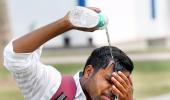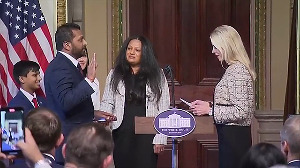Swathes of northern and eastern India remained in the grip of a punishingly long heatwave on Wednesday, increasing heat stroke casualties and prompting the Centre to issue advisory to hospitals to set up special units to cater to such patients.

A western disturbance may provide much-needed relief, though only marginally, over the next few days, according to the India Meteorological Department.
Also, conditions are now favourable for further advancement of the Monsoon which had made no significant progress between June 12 and 18, extending the wait for rains in north India which is reeling from the sweltering heat.
Maximum temperatures ranged from 43 to 45 degrees Celsius in many parts of Punjab, Haryana, Chandigarh, Delhi, Uttar Pradesh, and north Rajasthan, the IMD said.
In the national capital, hospitals reported a spike in cases of heat stroke and heat exhaustion and several deaths in the last two days.
The city recorded a maximum temperature of 43.6 degrees Celsius, over four notches above the normal. The minimum temperature in Delhi was 35.2 degrees Celsius, the highest in June since 1969.
At the Centre-run RML Hospital, authorities received 22 patients in the last two days. There have been five deaths and 12 patients are on ventilator support.
At the Safdarjung Hospital, there have been a total of 60 heatstroke cases, including 42 patients who have been admitted. The hospital has reported six casualties, including a 60-year-old woman and a 50-year-old man who died on Tuesday.
According to LNJP Hospital authorities, four patients have died due to suspected heatstroke in the last two days.
Union Health Minister JP Nadda reviewed the heatwave situation and preparedness of central government hospitals. He ordered that special heatwave units be started in the central government-run hospitals.
In an advisory to states, the Union Health Ministry gave directions for health facility preparedness and asked state Nodal Officers under National Programme for Climate Change and Human Health (NPCCHH) to start submitting daily the data on heatstroke cases and deaths and total deaths from March 1, 2024.
It called for maintenance of digital line list of heatstroke cases and deaths (suspected/confirmed) at health facility level and investigation of suspected heat related illness death by medical officer or epidemiologist.
The India Meteorological Department (IMD) said heatwave to severe heatwave conditions prevailed in parts of Uttar Pradesh, south Uttarakhand, Himachal Pradesh, Haryana, Chandigarh, Delhi, Punjab and pockets of Odisha, Jharkhand, Bihar and the Jammu division.
A fresh western disturbance is expected to bring some relief in the northern region from the high temperatures. Delhi can expect light rainfall on June 20.
Several places in Uttarakhand, including Dehradun received light showers on Wednesday after a prolonged dry spell. In Himchal Pradesh, thunderstorms and rains in Shimla and surrounding areas brought some respite.
The maximum temperature in Dehradun, which had shot up to around 40 degrees Celsius by Wednesday afternoon, plummeted sharply with the rains which were preceded by gusty winds.
In Haryana, Nuh recorded a high of 45.3 degrees Celsius, Faridabad 45 degrees Celsius, while Gurugram recorded 43.6 deg Celsius.
Chandigarh, the common capital of Punjab and Haryana, also sweltered under a maximum of 43.1 degrees Celsius. Sangrur in Punjab recorded 44.8 degrees Celsius, while Pathankot saw a high of 44.3 degrees Celsius.
The blistering heat has left a large number of people scrambling for water, with storage levels in reservoirs and rivers hitting record lows. The shortage of water for irrigation is impacting agriculture in some areas.
The power grids are under immense pressure and there has been an increase in incidents of short circuits and fires.
The Northern Regional Load Despatch Centre (NRLDC) Wednesday said multiple-tripping incidents were reported in the northern region on Monday after power demand shot up to 89.4 gigawatt (GW), leading to a supply gap of 16.5 GW.
Haryana, Delhi, Punjab, Uttarakhand, Himachal Pradesh, Uttar Pradesh, Rajasthan and J-K were the affected states, it said.
Massive consumption of electricity amid a punishing heatwave stretching over weeks pushed the peak power demand of Delhi to an all-time high level of 8656 MW on Wednesday afternoon, according to discom officials.
Cooling load due to the increased use of air conditioners and other cooling appliances amid the relentless heatwave has led to a record rise in power demand, they said.
Temperatures in Delhi have remained above 40 degrees since May 12. In these 36 days, the city saw 16 days when the mercury reached or surpassed 45 degrees.
The water crisis worsened by the heatwave prompted Delhi Water Minister Atishi to seek Prime Minister Narendra Modi's intervention. She threatened to go on an indefinite hunger strike from June 21 if the issue was not resolved soon.
IMD officials said high minimum temperatures or warm nights are exacerbating the impact of the deadly heat.
High night temperatures are considered dangerous because the body does not get a chance to cool down. Increasing nighttime temperature is more common in cities because of the urban heat island effect, in which metro areas are significantly hotter than their surroundings.
"This is scaring me. The minimum temperature in cities is not going down. People are not getting a chance to recover which means that we are getting more deaths at night than during the daytime, because normally the minimum temperature would fall and you would be able to recover to go back to work the next day, just not getting that," noted environmentalist Sunita Narain told PTI.
India is experiencing one of its hottest summers this time. Multiple heatwaves have pushed millions in the country to their limits and many states have reported heat-related deaths.
According to IMD, around 40 per cent of the country has recorded double the number of heatwave days than it usually does.
Rajasthan has hit 50 degrees Celsius twice over the last few weeks, and Delhi has recorded temperatures above 40 degrees Celsius for 36 consecutive days.
ON Wednesday, maximum temperatures were recorded two to five degrees Celsius above normal in Rajasthan's Jaipur, Kota, Udaipur and Bikaner divisions.
According to the Meteorological Center Jaipur, in the last 24 hours, rain was recorded with cloudy weather in some parts of eastern Rajasthan and the weather remained dry in western Rajasthan.
Experts attribute the scorching heat to climate change and the naturally occurring El Ni o phenomenon -- which is basically unusual warming of the ocean surface in the central and eastern Pacific Ocean.
While heat waves are common in India during April and May, scientists say climate change has made them more frequent and intense.
Data shows that 12 of the warmest years in India have occurred since 2006, with 2016 experiencing the highest temperatures to date.
The World Weather Attribution Group said similar heatwaves, which once occurred every 30 years, have become about 45 times more likely due to climate change.











 © 2025
© 2025